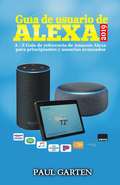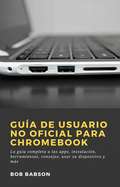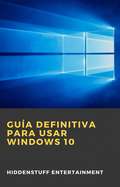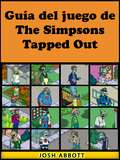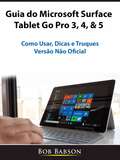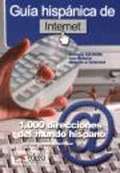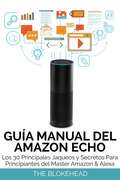- Table View
- List View
Guía de Usuario de Alexa 2019: A - Z Guía de referencia de Amazon Alexa para principiantes y usuarios avanzados
by Paul GartenAprende cómo usar Alexa con tu Smartphone y todos los dispositivos Amazon Echo. Edición 2019. Como el título sugiere, este libro está diseñado para ser una guía de referencia para todo lo que necesitas de los dispositivos Amazon Alexa y Echo smart. Descubre cómo configurar tus dispositivos Smart Home con Alexa. Domina tus Dispositivos Echo y Alexa en una hora. Mejora tu vida inteligente con esta guía. Desde Comunicación con Alexa, Skills, Entretenimiento, Productividad, Deporte, Compras por Voz, Noticias e Información, Configuración y Personalización dentro de la aplicación de Alexa, este libro lo cubre todo. Puedes tener una rápida vista previa del libro para ver su tabla de contenido.
Guía de Usuario de Amazon Echo: además de la completa guía de usuario y consejos
by Bob BabsonGuía de usuario de Amazon Echo: Dot, Show, Spot, Look, además de la completa guía de usuario y consejos por Bob Babson Una guía paso a paso sobre cómo sacar el máximo provecho de su dispositivo Amazon Echo Guía de usuario de Amazon Echo: Dot, Show, Spot, Look, además de la completa guía de usuario y consejos Una guía paso a paso sobre cómo sacar el máximo provecho de su dispositivo Amazon Echo * Admite todos los dispositivos Amazon Echo * La mejor característica del Echo es la inmensa funcionalidad que tiene. Aprenda a usar su dispositivo con todas sus capacidades, como lo hacen los profesionales Aquí está lo que obtendrás: -Compartir cuentas -Configuración -Alexa -Conectividad Bluetooth -Recordatorios -Rastreo de paquetes -Controlando otros dispositivos -Opciones -Actualización -Solución de problemas + ¡MUCHO MÁS! --> Desplácese a la parte superior de la página y haga clic en añadir al carrito para comprar instantáneamente... Descargo de responsabilidad: Este autor y/o propietario(s) de los derechos no hace ninguna reclamación, promesa o garantía sobre la exactitud, integridad o adecuación del contenido de este libro, y expresamente renuncia a la responsabilidad por errores y omisiones en el contenido del mismo. Este producto es sólo para uso de referencia.
Guía de Usuario no Oficial para Chromebook: La guía completa a las apps, instalación, herramientas, consejos, usar su dispositivo y más
by Bob Babson¿Usa su Chromebook regularmente? ¿Le gustaría aprender cómo usar su Chromebook como un profesional y ahorrárse montones de tiempo? Compatible con todas las versiones de Chromebook. Si su respuesta fue "sí" a cualquiera de estas preguntas, entonces esta guía es para usted. ¿Sabía que su Chromebook es capaz de miles de funciones, y que cada una de ellas hará su vida más fácil y le permitirá aprovechar mejor su tiempo? Sin embargo, debido a que hay tantas funcionalidades secretas, puede ser difícil saber exactamente cómo utilizar su dispositivo de forma óptima. Qué se incluye: -Cómo configurar. -Cómo navegar. -Capacidades del dispositivo -Cómo aprovechar mejor su tiempo -Cómo ahorrar esfuerzo y completar tareas con facilidad -Aprenda a utilizar su dispositivo como los profesionaless lo hacen. -Resolución de problemas + ¡MUCHO MÁS! Si quiere aprender a utilizar su dispositivo como los profesionales lo hacen, esta guía es para usted. --> Vaya al principio de la página y haga click en Añadir al Carrito Instantáneamente Advertencia: El autor y o el (los) propietario(s) de los derecho(s) no hacen ninguna declaración, promesa o garantía de la precisión, completitud o de la adecuación de los contenidos de este libro, y expresamente niegan responsabilidad alguna por errores y omisiones en los contenidos aquí expuestos. Este producto es para uso referencial únicamente. Por favor consulte a un profesional antes de actuar en base a cualquiera de los contenidos presentados a continuación.
Guía de usuario para principiantes de Excel 2022
by Kylie CoxExcel es el software de hoja de cálculo más popular en el mundo, y por una buena razón. Es excelente, versátil, y fácil de utilizar, convirtiéndolo en una gran elección para uso personal y profesional. Excel tiene algo que ofrecerte, bien sea que estás comenzando con las hojas de cálculo, o eres un profesional experimentado. En esta guía de principiante, cubriremos las bases de Excel, de manera que puedas empezar a trabajar rápidamente.
Guía definitiva para usar Windows 10
by Hiddenstuff EntertainmentEste libro en Windows 10 es una breve guía del usuario. Enumera la forma de hacer una variedad de cosas allí usando la barra de búsqueda y dice exactamente en qué hacer clic para realizar muchas acciones necesarias. Básicamente, le dice a alguien cómo navegar por el sistema para poder usarlo de la manera más efectiva.
Guía Del Idiota Total Para Vender En Ebay
by Nick Vulich José Ramón TorresDescripción del libro:Guía del idiota total para vender en eBay es tu guía personal para hacer dinero en eBay. Su autor, Nick Vulich, ha realizado más de 29 000 transacciones en eBay en los últimos 13 años. Conoce los entresijos de las ventas en eBay y se ofrece para guiarte durante el proceso de venta.¿Te preocupa que no tengas nada que vender?No tienes por qué. Mira a tu alrededor. Todo el mundo tiene decenas de objetos en la casa y el garaje que puede empezar a vender hoy mismo. El hecho de que ya no uses tu viejo aparato de vídeo, sistema de juegos o portátil no significa que otra persona no lo quiera. A la gente le encanta las gangas. Ayúdalos a conseguir lo que quieren y échate algo de dinero al bolsillo en el proceso.Vamos a aprender cómo:Decidir qué venderAbrir una cuenta de vendedor en eBayAbrir una cuenta en PayPal (para que te paguen, RÁPIDO)Anunciar tu primer artículo en eBay con instrucciones paso a pasoOptimizar tus ventas con 28 consejos y trucosEnviar tus artículosInvestigar sobre artículos para obtener el mejor precio en cada ocasiónPrestar servicios al cliente, al estilo eBayNo dejes que el miedo te lo impida.Se calcula que más de 450 000 personas se ganan la vida vendiendo artículos en eBay.Millones de otras usan eBay para obtener dinero adicional y comprarse un coche, pagar la escuela de sus hijos o irse de vacaciones. ¿Por qué no tú?Otros millones quisieran vender en eBay, pero tienen miedo.Guía del idiota total para vender en eBay te conducirá paso a paso por el proceso de decidir qué vender, crear una cuenta en eBay y PayPal, y anunciar tu primera subasta.Todo esto se puede lograr en menos de una hora.No esperes otro minuto. ¡Pide tu copia de este libro hoy!
Guía del juego de The Simpsons Tapped Out
by Marina García Rodríguez Joshua Abbott¡Construye la mejor ciudad y consigue mucho dinero! Con la guía del juego de The Simpsons Tapped Out (o Los simpsons Springfield), aprenderás exactamente todo lo que necesitas para convertirte en un jugador experto, ¡y ganarás rosquillas y dinero ilimitados! Este libro es una guía completa sobre todo lo que necesitas saber del juego. ADEMÁS, también podrás bajarte la versión gratuita del juego con esta compra. - ¡Cómo descargar The Simpsons Tapped Out (o Los simpsons Springfield) GRATIS! - Válido para iPhone y Android. - Vista general e información básica - ¡Estrategias avanzadas para progresar en el juego! - ¡Consigue dinero ilimitado! - ¡Consigue rosquillas ilimitadas! - ¡Cómo subir de nivel más rápido! - ¡Cómo conseguir rosquillas gratis! - Ubicaciones y su código postal. - Modos de juego y logros. - Instrucciones detalladas fáciles de seguir. - ¡Los secretos, trucos y objetos descargables que solo los jugadores profesionales usan! - ¡Y MUCHO MÁS! ¡Compra ahora y no te quedes nunca más sin rosquillas! ¡Vuélvete uno de los mejores jugadores ahora! Descargo de responsabilidad: Este producto no se ha asociado, afiliado, relacionado ni financiado por EA Games, ni ha sido revisado, probado o certificado por EA Games. Esta guía debe servir como referencia, por lo que no modifica el juego de ninguna manera. Es una guía escrita y no un programa de software.
Guía del usuario de la cámara del iPhone 14 Pro Max: El manual completo para que los principiantes aprendan a hacer fotos profesionales
by Wendy HillsSi estás deseando tener en tus manos el nuevo iPhone 14 Pro Max, si todavía estás esperando a que llegue tu iPhone, o si todavía no has pedido tu iPhone 14 Pro Max pero quieres una guía de usuario con ilustraciones que sea fácil de entender, escrita con una gramática sencilla y que te muestre cómo empezar a utilizar rápidamente tu iPhone, entonces este libro es para ti. Te mostrará cómo utilizar tu recién adquirido iPhone 14 Pro Max. El iPhone 14 Pro Max es sin duda el mejor iPhone disponible ahora mismo. Sus cámaras, su gran pantalla, su increíble diseño y su pantalla inteligente son solo algunas de las características que lo han convertido en el teléfono más comentado del mercado. El Apple iPhone 14 Pro Max es un smartphone insignia de gama alta con características avanzadas. Cuenta con una pantalla Super Retina XDR de 6,7 pulgadas, Always-On Display, funciones de visualización mejoradas y una rápida CPU A16, entre otras novedades. Esta guía de usuario te enseñará paso a paso cómo utilizar y dominar las funciones del iPhone 14 Pro Max. Al final de este libro, podrás destacar entre aquellos que solo utilizan el iPhone 14 Pro Max para cosas básicas. La compra de esta guía del usuario y su combinación con el iPhone 14 Pro Max ofrece numerosas funciones y ventajas adicionales. Este libro adopta un enfoque visual único, con instrucciones paso a paso y consejos profesionales que te enseñarán a utilizar tu iPhone 14 Pro Max como un profesional. Esta guía explica funciones complejas y básicas, consejos y trucos, y cómo configurar y utilizar eficazmente tu iPhone 14 Pro Max. Este libro contiene numerosas ilustraciones que te ayudarán a seguir la lectura a lo largo de sus páginas. Ya puedes dejar de pedir a tus hijos que te enseñen a usar el iPhone.
Guía del usuario de MacOS Ultimate
by Adidas Wilsona primera computadora exitosa con una GUI, la capacidad de permitir a los usuarios obtener una vista previa de un documento antes de imprimir, y un mouse fue la Mac. Las siguientes son las razones por las que ha seguido siendo relevante durante todos estos años. Iconos convertidos en arte. Dado que Mac fue la primera computadora con una GUI, fue la primera en tener íconos. Susan Kare diseñó esos primeros íconos para Mac. Las Mac ruegan por estar en red. Cuando se lanzó Mac, las redes informáticas eran exóticas y caras; pero incluso entonces, las Mac podrían conectarse fácilmente entre sí. HyperCard inspiró parcialmente la Web. La HyperCard fue creada por Bill Atkinson en 1987. A través de esta aplicación, cualquiera podía crear tarjetas en pantalla con hipervínculos, imágenes o textos. La computadora portátil Mac viene avanzada desde el primer momento, viene con muchas herramientas básicas como administración de calendario, correo electrónico, etc. Sin embargo, hay otro mundo de software poderoso para Apple Mac que facilitará las tareas complicadas. Aunque la mayoría de ellos no son gratuitos, solo cuestan unos pocos dólares y valen la pena. Aquí están algunos de los mejores.
Guia do Jogo 8 Ball Pool
by Joshua Abbott Márcia de Medeiros Souza*GUIA NÃO OFICIAL* Dicas avançadas e guia de estratégia. Esta é o guia com mais informações e o mais detalhado que encontrará online. Disponível para download instantâneo em seu telefone, eBook ou em paperback. Com o sucesso de centenas de outros guias online e estratégias, escrevi este guia profissional avançado para novatos e veteranos. Ele mostra estratégias específicas e dicas de como progredir no jogo, vencer seus oponentes, ganhar moedas e dinheiro e muito mais! - Dicas e estratégias profissionais. - Hacheio o jogo. - Dicas secretas, hacks, desbloqueios e truques usados pelos jogadores Pro! - Como conseguir toneladas do dinheiro/moedas. - E MUITO MAIS! Todas as versões deste guia têm prints de tela que lhe ajudarão a entender o jogo. Não há nenhum outro guia tão detalhado e com mais informações.
Guia do Jogo Clash of Clans
by Juliana Dias Borges Joshua AbbottVença os seus adversários! *Versão do Guia Não-Oficial* Além de comprar este eBook sinta-se livre para inscrever-se para o nosso programa suplementar do guia grátis. Copiando o link abaixo você terá acesso às últimas atualizações para os mais populares aplicativos online e jogos de vídeo. Registe-se gratuitamente abaixo: http://emailsignupform.subscribemenow.com/ Dicas avançadas & Guia de Estratégia. Este é o guia mais completo e detalhado que você vai encontrar online. Disponível para download imediato em seu telefone móvel, dispositivo de e-book, ou em forma de livro. Com o sucesso dos meus centenas de outros guias e estratégias escrevi, escrevi um outro guia profissional avançado para os jogadores novos e veteranos. Isto dá estratégias e dicas específicas sobre como progredir no jogo, vencer os seus adversários, adquirir mais moedas e dinheiro, e muito mais! Aqui está o que você vai ter quando você compra este guia jogo profissional avançada e detalhada. - Dicas profissionais e Estratégias. - Códigos e Macetes. - Segredos, Dicas, Cheats, Destraváveis e truques usados pelos jogadores profissionais! - Como conseguir toneladas de dinheiro / Moedas. - E MUITO MAIS! Todas as versões deste guia tem imagens para ajudar você a entender melhor o jogo. Não há nenhum outro guia que é tão abrangente e avançado como este. Se você está procurando guias sobre outros jogos populares e títulos de aplicativos sinta-se livre para procurar outros títulos por Joshua J Abbott ou HSE Games. Você estará feliz que você comprou este guia e irá beneficiar-se muito com ele em comparação com os outros guias menos eficazes por aí. Compre agora e esmague seus adversários! Torne-se um Jogador Profissional Hoje! Para suporte e obter mais informações sobre nossos produtos, visite: http://www.hiddenstuffentertainment.com/ Aviso Legal: Este produto não está ass
Guia do Microsoft Surface Tablet Go Pro 3, 4, & 5: Como Usar, Dicas e Truques (Versão Não Oficial)
by Bob BabsonIntrodução, Configuração, Como usar, Dicas, Truques, Acessórios e muito mais! Descrição do livro: Você usa o seu dispositivo Microsoft Surface regularmente? Deseja aprender a usar o seu dispositivo Microsoft Surface como ninguém e economizar tempo? Compatível com todas as versões Go e Pro 2, 3 e 4. Se você respondeu sim a alguma dessas perguntas, este guia é para você. Você sabia que o seu dispositivo Microsoft Surface é capaz de milhares de funções, o que facilitará sua vida e permitirá que você economize mais tempo. No entanto, como existem muitas funções secretas, pode ser difícil saber exatamente como usar seu dispositivo de forma otimizada. O que está incluído: -Como configurar. -Como navegar. Recursos de dispositivos. -Como economizar tempo. -Como economizar esforço e concluir tarefas com facilidade. -Saiba como usar seu dispositivo como os profissionais. -Resolver problemas. + MUITO MAIS! Se você quiser aprender a usar o dispositivo como ninguém, este guia é para você. -> Role até o topo da página e clique em adicionar ao carrinho para comprar instantaneamente Aviso Legal: Este autor e ou o(s) proprietário(s) dos direitos não faz reivindicações, promessas ou garantias com relação à precisão, integridade ou adequação do conteúdo deste livro e se isenta expressamente da responsabilidade por erros e omissões no conteúdo deste. Este produto é apenas para uso de referência. Consulte um profissional antes de agir sobre qualquer um dos conteúdos encontrados nele.
Guia do Usuário não Oficial do Chromebook: O Guia Completo para Aplicativos, Configuração, Ferramentas, Dicas, Uso do Dispositivo e Muito Mais
by Bob BabsonGuia do usuário não oficial do Chromebook: o guia completo para aplicativos, configuração, ferramentas, dicas, uso do dispositivo e muito, Este material guia é para referência pessoal será de grande utilidade e benéfico para seu aperfeiçoamento, habilidades e conhecimento do item descrito.
Guía extraoficial para Samsung Galaxy Tab 3,4 y S
by Hiddenstuff Entertainment¿Usas tu dispositivo Smsung de manera regular? ¿Te gustaría aprender a usar tu dispositivo como un profesional y ahorrar bastante tiempo? Compatible con todas las versiones 3,4, and S. Si tu respuesta a estas preguntas es si, entonces esta guía es para ti. Lo que aprenderas: -Como configurar. -Como navegar. -Capacidad deldispositivo. -Como ahorrar tiempo. -Como ahorrar esfuerzos y completar taareas con facilidad. -Aprender a usar tu dispositivo como un profesional. -Solucionar problemas del dispositivo. Y mucho más
Guía hispánica de Internet: 1,000 direcciones del mundo hispánico
by Alfredo González HermosoNo disponible
Guía Manual del Amazon Echo: Los 30 Principales Jaqueos y Secretos Para Principiantes del Master Amazon & Alexa
by The BlokeheadSu guía perfecta para el Amazon Echo! Este libro es un complemento y práctico compañero para principiantes que le permitirá a usted el ajusta y usar su dispositivo Amazon Echo rápida y eficientemente. Leyendo este libro usted entenderá y será capaz de recibir todos los beneficios que este maravilloso dispositivo tiene para ofrecer, permitiéndole a usted el mantener al día su apretada agenda. Usted aprenderá: Jaquear el control remoto. Controlar los dispositivos WEBO falsos. Controlar las luces y la temperatura. Conocer los mejores comandos. Y un montón más. Descárguelo AHORA y empiece a leer.
Guia Não-Oficial de Pokémon Omega Ruby e Alpha Sapphire
by Guilherme De Oliveira Joshua Abbott*GUIA NÃO-OFICIAL* Além de comprar este eBook, sinta-se livre para registrar seu email para o programa de guia suplementar gratuito. Copiando o link abaixo você ganha acesso as atualizações mais recentes sobre os jogos mais populares, apps mobile e dispositivos da atualidade! Registre-se gratuitamente abaixo: http://emailsignupform.subscribemenow.com/ Dicas Avançadas & Guia de Estratégias. Este é o mais detalhado e compreensível guia que você encontrará online. Disponível para download instantâneo no seu smartphone, tablet ou leitor de eBooks. Com o sucesso das minhas centenas de guias e estratégias que eu escrevi antes para jogadores iniciantes e veteranos. Este dá estratégias específicas e dicas em como progredir no jogo, vencer seus oponentes, adquirir mais dinheiro e muito mais! Aqui vai o que você vai encontrar quando comprar este guia professional avançado e detalhado: - Dicas e Estratégia Professionais; - Cheats e Hacks; - Segredos, Dicas, Cheats, Desbloqueáveis, e Truques utilizados por jogadores profissionais; - Como conseguir muito dinheiro; - E MUITO MAIS! Você ficará feliz que comprou este guia e se beneficiará dele muito mais se comparado a outros guias menos eficazes por aí. Compre agora e destrua seus oponentes! Torne-se um jogador profissional hoje! Para suporte técnico e mais informações sobre nossos produtos, acesse: http://www.hiddenstuffentertainment.com/ Aviso: Este produto não é associado, afiliado, endossado, certificado, ou patrocinado pelos Donos Originais dos Direitos Autorais. Todas as mascas registradas presentes nesse guia são de propriedade de seus respectivos donos.
Guia Não Oficial do Jogo Candy Crush Jelly Saga
by Hiddenstuff Entertainment Débora L. SousaPasse níveis, obtenha power-ups e a pontuação máxima! *GUIA NÃO OFICIAL* Além de comprar este e-book, fique à vontade para se inscrever no nosso programa suplementar de guias gratuitos. Ao copiar o link abaixo, você terá acesso às atualizações mais recentes dos aplicativos e videogames online mais populares. Inscreva-se gratuitamente abaixo: http://emailsignupform.subscribemenow.com/ Guia Avançado de Dicas e Estratégias. Este é o guia mais completo e detalhado que você encontrará online. Disponível para download instantâneo no seu celular, dispositivo para e-books ou em formato impresso. Com o sucesso das minhas centenas de outros guias e estratégias, resolvi escrever outro guia profissional avançado para os jogadores novos e veteranos. Ele apresenta estratégias e dicas específicas sobre como avançar no jogo, derrotar os seus adversários, adquirir mais moedas e dinheiro e muito mais! Você receberá o seguinte quando comprar este guia de jogo profissional avançado e detalhado: - Dicas e estratégias profissionais - Trapaças e hacks - Segredos, dicas, trapaças e truques usados por jogadores profissionais - Como ganhar muito dinheiro/moedas - E MUITO MAIS! Todas as versões deste guia têm capturas de tela para ajudar a entender melhor o jogo. Não existe outro guia tão completo e avançado como este. Você agradecerá por ter comprado este guia e será bastante beneficiado quando comparado com outros guias menos eficazes por aí. Compre agora e derrote os seus adversários! Torne-se um jogador profissional hoje mesmo! Para suporte e mais informações sobre os nossos produtos, favor visitar: http://www.hiddenstuffentertainment.com/ Termo de responsabilidade: Este produto não está associado, afiliado, apoiado, certificado ou patrocinado pelo Proprietário Original dos Direitos Autorais. Todas as marcas registradas que aparecem nes
Guia Não Oficial do Jogo Candy Crush Soda Saga
by Renato Santana dos Santos Joshua AbbottVença Níveis, Obtenha Power-Ups e as Melhores Pontuações! Com o meu Guia de Jogo Completo do Candy Crush Soda Saga você aprenderá absolutamente tudo sobre o jogo! As estratégias mencionadas neste guia são conhecidas apenas pelos jogadores de elite com as melhores pontuações. Meu guia abrange o seguinte: - Visão geral e informações básicas sobre o Candy Crush Saga. - Itens e Combos úteis, e o que eles fazem. - Como conseguir mais Vidas. - As melhores combinações de doces para vencer os níveis e conseguir altas pontuações. - Estratégias para todos os tipos de nível. Como vencer qualquer nível! - Segredos, dicas e truques usados pelos jogadores profissionais! - Instruções detalhadas passo a passo! - Estratégias gerais de jogabilidade. - E MUITO MAIS! Compre agora e nunca mais fique preso tentando vencer um nível, ou sem vidas! Torne-se um Jogador com excelente pontuação Hoje! Este produto não é associado, afiliado, endossado ou patrocinado pela King ou Midasplayer.com Limited, e tampouco foi revisado, testado ou certificado por eles. Este guia deve ser usado como referência. Isto não modifica ou altera o jogo de nenhuma maneira. Este é um guia escrito, e não um programa de software.
Guia Não Oficial do Jogo Halo 5 Guardians
by André de Oliveira Garcia Joshua AbbottDescrição: *Versão do Guia Não Oficial* Guia com dicas e estratégias avançadas. Este é o guia mais abrangente e o mais detalhado que você encontrará online. Disponível para download instantâneo no seu celular, em leitores de livros digitais ou em edição de bolso. Abaixo está alistado o que você vai conseguir quando comprar este guia profissional, avançado e detalhado. -Dicas e Estratégias Profissionais -Cheats e Hacks -Segredos, Dicas, Truques, Desbloqueios e Técnicas Usadas por Jogadores Profissionais! -Como Conseguir Muito Dinheiro/Coins -E MUITO MAIS! Isenção de Responsabilidade: Este produto não está associado, afiliado, endossado, certificado ou patrocinado pelo Proprietário Original dos Direitos Autorais. Todas as marcas registradas que aparecem neste e-book são de propriedade de seus respectivos proprietários.
Guia não-oficial para Pokémon GO
by Thaís Vidal e Rodrigo Radetic Joshua AbbottGuia não-oficial para Pokémon GO por Joshua Abbott Vença os seus adversários! *GUIA NÃO OFICIAL* Dicas Avançadas & Guia de Estratégia. Este é o mais abrangente e o único guia detalhado que você vai encontrar online. Disponível para download imediato em seu celular, leitor de eBook, ou em formato brochura. Com o sucesso de centenas de outros guias de estratégia escritos, eu escrevi outro guia avançado profissional para jogadores novos e veteranos. Ele dá estratégias e dicas específicas em como progredir no jogo, vencer seus adversários, adquirir mais moedas e muito mais! - Dicas profissionais e estratégias. - Cheats e Hacks. - Segredos, dicas, cheats, desbloqueáveis, e truques usados pelos jogadores profissionais! - Como conseguir muito dinheiro/moedas. - E MUITO MAIS! Todas as versões desse guia possui screenshots para ajudá-lo a compreender melhor o jogo. Não há outro guia tão abrangente e avançado quanto este. Aviso: Este produto não é associado, afiliado, aprovado, certificado ou patrocinado pelos Originais Detentores dos Direitos Autorais.. Gênero: JOGOS / Vídeo e Eletrônicos Sub-gênero: JOGOS / Referência Idioma: Português Número de Palavras: 3000
Guía No Oficial de Bubble Witch Saga 2
by Trans. Perla Allin Guzman Vargas Joshua AbbottGuía de juego no oficial de Bubble Witch Saga, descripción, contenido, atajos, trucos y más!
Guía No-Oficial de Dragon City
by Josh Abbott Hugo González Bruno¡Vence a tus oponentes! Con mi guía de juego aprenderás exactamente lo que hay que saber para convertirse en un jugador experto y vencer a tus oponentes. Esta es una guía completa con todo lo que necesitas saber sobre el juego, además de una copia gratuita del juego con esta compra. - ¡Como descargarlo de forma gratuita! - Compatible con iPhone, Android, y PC. - Información general e información básica - Consejos y estrategias profesionales. - Conseguir gemas. - Obtener comida. - Todo sobre torneos. - Todo sobre tipos de edificios. - Cómo hacer toneladas de oro. - Información de crianza de dragones. - Hábitats de dragones. - Instrucciones detalladas fáciles de seguir. - ¡Secretos, Consejos, Trucos, Desbloqueables, además de trucos usados por los jugadores profesionales! - ¡Y mucho más! ¡Comprala ahora y aplasta a tus oponentes! ¡Conviértete en un jugador profesional ahora! Por favor, ten en cuenta: Este producto no está asociado, afiliado, respaldado o patrocinado por Social Point, ni tampoco ha sido revisado, probado o certificado por ellos. Esta guía está para ser utilizada como una referencia y, como tal, no modifica el juego de ninguna manera. Esta es una guía completa y no un programa de Software.
Guía No Oficial de Dragon Mania Legends
by Carlos A. Valenti García Joshua Abbott*GUÍA NO OFICIAL* Consejos Avanzados & Guía de Estrategias.Esta es la guía más completa y detallada que encontrarás en lína. Disponible para descargar en tu dispositivo móvil, celular, lector de Ebooks, o en forma física. Con el éxito de mis cientos de guías escritas y estrategias he escrito otra avanzada guía profesional para jugadores nuevos y veteranos. ¡Contiene estrategias y consejos específicos para progresar en el juego y vencer a tus ponentes, adquirir más monedas, y muchas cosas más! - Consejos y Estrategias Profesionales. - Trucos. - ¡Secretos, Consejos, Trucos, Desbloquables, y Estrategias Usadas Por Profesionales! - Cómo Obtener Tonaladas de Monedas. - ¡Y MUCHO MÁS! Todas las versiones de esta guía incluyen capturas de pantalla para ayudarte a entender mejor el juego. No existe guía más completa y avanzada que esta. Disclaimer: Este producto no está asociado, afiliado, endosado, certificado, o patrocinado por el Acreedor Original de Derechos de Autor.
Guía No-Oficial de Grand Theft Auto V
by Hugo González Bruno Joshua Abbott¡Haz toneladas de dinero! ¡Con mi guía no oficial de Grand Theft Auto 5 aprenderás exactamente lo que es necesario saber para convertirte en un experto! Mi guía cubre lo siguiente: - Estrategias para principiantes. - Consejos y estrategias para profesionales. - Iniciando. - Cómo ganar dinero infinito. - Armas. - Vehículos. - ¡Secretos, Consejos y Trucos utilizados por los jugadores profesionales! - ¡Y mucho más! ¡Cómpralo ahora y no vuelvas a tener bajo rendimiento! ¡Conviértete en un jugador experto ahora! Cláusula de renuncia: Este producto no está asociado, afiliado, aprobado o patrocinado por Rockstar Games. Esta guía es para ser utilizado como una referencia. El objetivo de esta guía es ser utilizada como referencia. Esta es una guía escrita y no un programa de software.
